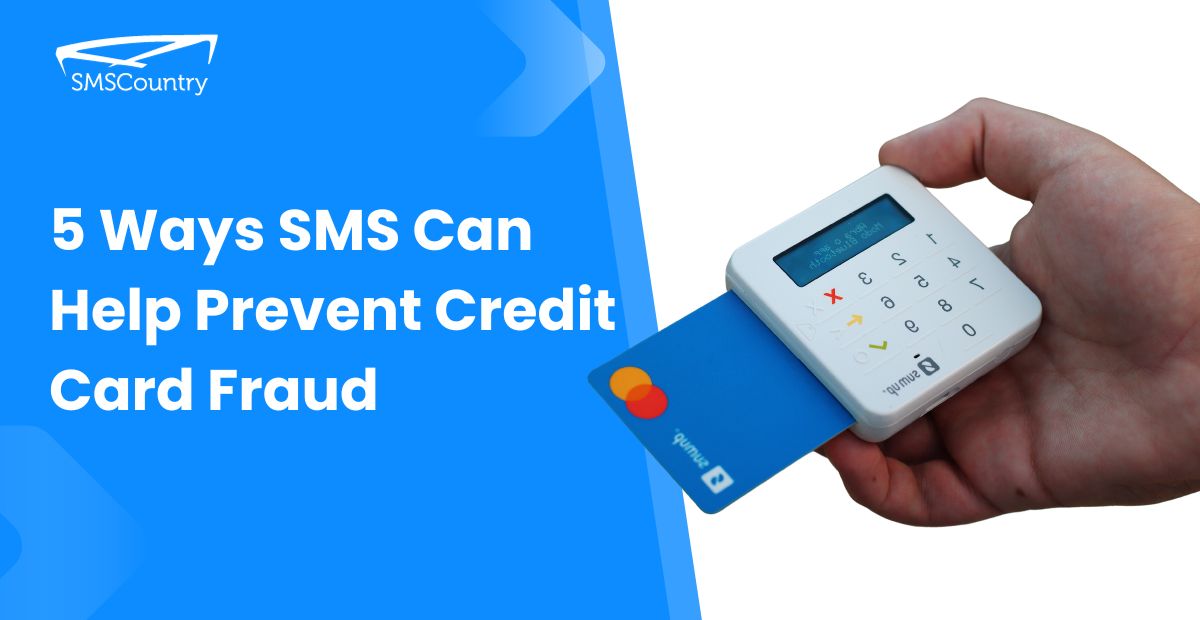Credit card fraud is a big headache for banks, credit card companies, and your customers.
It doesn’t only lead to losses but can also ruin the trust of your customers.
What if we told you there are ways to prevent credit card fraud?
There is a tool, and it’s SMS. SMS could be your new ally in this fight against fraud.
In this article, we’ll outline 5 unique ways to prevent credit card fraud with the power of SMS. Using these, you can reduce fraud and secure your business operations.
But first, let’s get to know what card fraud is.
What is credit card fraud?
Credit card fraud is when an individual uses another person’s information. They then make unauthorised purchases or access the funds of the victim.
Credit card fraud can occur in various ways:
- Physical theft
- Phishing scams
- Data breaches
- Card skimming
You are likely already well-versed in this as a business owner, executive, or cyber security officer/developer.
But did you know that fraudsters are finding new ways to bypass your bank’s security measures?
Not only does this make your job hard, but it could also hurt your customers.
As someone responsible for stopping fraud, what should you do?
Identifying and combating fraud is the first step. It doesn’t stop there. You also need to expect future threats and develop measures.
In the next section, we delve deeper into the impact of fraud on banks and credit card companies.
What is the impact of credit card fraud on banks and credit card companies?
Credit card fraud affects banks and credit card companies in various ways.
See how:
- Losses: Companies often bear the cost of fraud. They reimburse their customers for their losses. This affects the companies’ profits and bottom line.
- Increased costs: Companies must invest in better security systems as fraud increases. This leads to higher operational expenses.
- Brand damage: Fraud incidents can damage a company’s reputation and erode customer trust. This could lead to a loss of business and revenue.
- Scrutiny: Fraud incidents can result in regulatory penalties and heightened scrutiny. This adds to operational complexities.
- Customer experience: Customers affected by fraud often face stressful aftermath. This includes reporting the incident, replacing the card, and undergoing reimbursement. This can affect their experience.
Understanding these impacts will help you understand the importance of fraud prevention measures. Let’s learn about it in the next section.
What are the consequences of credit card fraud?
Implementing robust fraud prevention measures is crucial. Here are a few reasons why you should do it today:
- Customer trust: Protecting your customers helps build and maintain their trust in you. It shows that you focus on their security and financial well-being.
- Financial health: Preventing fraud reduces financial losses related to reimbursements. This contributes to the financial health of your company.
- Operational efficiency: An effective fraud prevention strategy can help streamline operations. It reduces the time and resources spent on handling fraud incidents.
- Regulatory compliance: As a company, following regulations can help avoid penalties. Not only that, but you can also maintain good standing with regulatory bodies.
- Brand reputation: Having robust fraud prevention methods will enhance your brand. This can help prevent fraud and get new customers as well.
Implementing effective preventive measures against credit card fraud is not only a necessity. It is a strategic move that can benefit your company in many ways.
Let’s check out how SMS can be a viable part of this strategy in the next section.
| SMSCountry is the best bulk SMS service to secure customers’ credit card information and transactions. Learn more about our SMS services. Get started or schedule a demo. |
How can SMS enhance security measures for your bank or credit card company?
SMS is a powerful tool. Its broad reach, immediacy, and simplicity effectively combat fraud.
Here’s how:
- Real-time alerts: Using SMS, you can send alerts to customers about their transactions. You can flag unusual activity instantly, allowing quick action.
- Two-Factor Authentication: SMS can provide an extra layer of security with 2FA. When entered, a unique code sent via SMS will approve certain transactions.
- Fraud prevention education: Regular SMS can educate customers about the latest fraud trends. You can also teach how to avoid them, fostering a proactive approach to security.
- Customer verification: SMS can help verify customer identity. This can be during phone banking or online. This allows for enhanced security of transactions.
- Account updates: If there are changes to a customer’s account, you can send a confirmation SMS. This helps prevent unauthorised alterations.
Copy and use the best SMS templates for financial services
In the following sections, we will explore how you can use SMS to prevent credit card fraud in your company.
What are the 5 ways SMS can prevent credit card fraud?
Credit card fraud poses a significant challenge to financial institutions worldwide. One effective way of preventing fraud is using Short Message Service (SMS).
Let’s discover the 5 ways you can use SMS to prevent credit card fraud and protect your customers’ credit cards.
1. Two-factor Authentication (2FA) via SMS
2FA is a robust security protocol that adds a layer of protection to passwords. It requires your users to authenticate their identity through two distinct methods.

For credit card transactions, your customer already has a password or PIN. The second factor is what the user has physical access to. It could be a mobile phone, where you, as the bank, will send the One-Time Password (OTP).
Including SMS in the 2FA process enhances the safety and security of transactions and customers’ credit cards. This is because a fraudster must have the password and your customers’ phones to scam them.
Consider this scenario:
Your customer initiates an online transaction using their credit card. After entering their details, they receive an OTP to the registered mobile number. The customer then enters the OTP to authenticate the transaction.
Even if a fraudster has the card details, they still need the OTP to complete the transaction.
This is how 2FA reduces the risk of fraud.
SMS OTPs offer a lot of advantages for banks/credit card companies:
- They are convenient and easy to use.
- They are cost-effective and provide enhanced protection to your customers
All these make SMS an effective tool in the fight against credit card fraud.
By incorporating 2FA via SMS in your organisation, you ensure the following:
- Safeguarding of your customer data
- Maintaining the integrity of your operations
- Cultivating trust among your users
Your bank or credit card company can use SMSCountry to send fast and secure OTP to your customers to complete online transactions.
You can get started or schedule a demo to see how to use SMSCountry SMS and WhatsApp messaging services to send OTPs to your customers.
2. SMS alerts for real-time transaction monitoring
Real-time transaction monitoring is a critical element of a fraud prevention strategy. By keeping a close eye on all ongoing transactions, you can respond to unusual activities.
Implementing real-time transaction monitoring via SMS alerts adds an extra level of security.

This technique involves sending an SMS alert to your customer’s mobile number. This alert goes via an SMS whenever a credit card transaction happens.
If the transaction is legitimate, the customer knows it and can keep track of their spending. If it is fraudulent, the customer can take prompt action by letting your bank know.
Consider this use case:
You notice transactions on your customer’s card occurring in a foreign country. Your system recognises this unusual activity and immediately alerts them via SMS. Since the customer isn’t aware, they will contact you to report it. As the bank, you can block the card and investigate the issue.
These real-time SMS alerts offer many benefits to banks and credit card companies.
SMS alerts improve customer security and the relationship between you and your customers.
You can use SMSCountry transactional messaging services to send transaction alerts to your customers. You can do it both through SMS and WhatsApp.
3. SMS alerts for account activity
Staying informed about account activities is vital for financial health and security. Regular account updates via SMS can alert your customers to any irregularities.
You can send your customers daily or weekly account balance updates via SMS. These updates not only keep the customers informed about their financial position. But also allows them to identify any unaccounted-for changes in their account balance.
That’s not all. You can send SMS notifications for various account activities, such as:
- Deposits
- Withdrawals
- Payments
- Changes in account details
- Cheque bounce
In the event of unauthorised activity, your customer can immediately contact you.
Consider this use case:
A customer receives an SMS alert notifying them of a change in their email address—a change they did not make. The customer immediately contacts you to suspend the account and launches an investigation.

The SMS enables your customer and you to act. This helps in minimising potential damages and enhances account security.
Proactive monitoring of accounts through SMS offers benefits to you and your customers. It instils confidence in your customers and enhances customer engagement.
SMS alerts for account activity help in creating a secure and trustworthy environment.
4. SMS for customer education
Education and awareness are crucial elements in the battle against credit card fraud. You can use SMS to educate your customers about fraud and promote safe practices.
You can use SMS campaigns to send an SMS highlighting common fraud tactics. This could be about phishing scams, SIM hacks, and data breaches. This will educate your customers on how to recognise them.
These campaigns can also provide tips on how to protect personal information online. You could take it a step further by educating your customers if they’ve been a victim of fraud.
Consider this use case:
Your bank launches an SMS campaign to raise awareness about a new type of phishing scam.
Your customers will receive a simple, clear SMS that will:
- Explain the scam
- How to recognise it
- Steps to take if they encounter it
As a result, when your customer receives a scam message that fits the description in the SMS, they will know it’s a scam and immediately report it to the bank.
Educating your customers through SMS reduces the risk of them falling victim. It also reinforces their confidence in your commitment to their security. This proactive approach helps create a safer banking environment for your customers.
5. SMS-based PIN reset and account recovery
Every bank must offer a secure PIN reset and account recovery process.
SMS is an effective way to do PIN resets and account recovery. They are simple to use and also have high-security standards.
For instance, you can use SMS to allow customers to reset their credit card PIN. When your customer requests a PIN reset, a secure link or an OTP gets sent to their registered mobile number.
This SMS verifies that the request is authentic and allows them to create a new PIN in a secure environment.
Also, SMS plays a massive role in the account recovery process. If your customer cannot access their account, they can request account recovery. You can then send a secure link or OTP via SMS to verify the customer’s identity and make the account recovery.
Consider this use case:
A customer forgets their online banking password. They choose the ‘Forgot Password’ option, and you send an OTP to their registered mobile number. The customer enters the OTP and is then allowed to reset their password.
SMS-based PIN reset and account recovery methods provide an extra layer of security. They enhance the customer experience by offering a secure way to resolve issues. These practices show your commitment to customer service and security.
Now that we know the 5 ways you can use SMS to prevent credit card fraud. Let’s move to the next section to learn more about the challenges associated with SMS.

What are some challenges of using SMS to prevent credit card fraud?
While using SMS as a fraud prevention measure brings many benefits, it also comes with challenges.
Let’s check out these issues with using SMS to prevent credit card frauds and the solutions.
1. SIM card swapping
SIM card swapping is when criminals transfer a victim’s phone number to another SIM card. With this action, they access all SMSes intended for the victim.
These include OTPs for banking transactions or account recovery links. This poses a significant threat to financial security.
Solutions to overcome SIM card swapping threats
Use these solutions if you experience this challenge:
- Multi-Factor Authentication (MFA): Incorporate different authentication methods beyond SMS. Use biometric data or security questions to verify your customer’s identity.
- Customer education: Inform your customers about the possibility of SIM swapping attacks. Ensure that you educate them to recognise the signs.
- Alerts for SIM change: Ensure a system emails customers if a SIM change occurs.
2. SMS interception
Another common method criminals use to commit fraud is SMS interception. This can happen through the installation of malware on your customer’s phone. The criminal can read or redirect SMS and gain access to sensitive information.
Solutions to mitigate SMS interception risks
Let’s explore some solutions to this challenge:
- Encrypted messaging: Use encrypted SMS to prevent unauthorised interception.
- Regular software updates: Encourage your customers to keep their devices updated.
- Device security education: Educate your customers on safe device practices.
3. SIM cloning
SIM cloning is a huge challenge when using SMS for fraud prevention measures. In a SIM cloning attack, the attacker duplicates your customer’s SIM card.
By doing this, they receive the same SMS as the victim. This allows for the interception of SMS, which is dangerous for your customers.
Solutions to mitigate SIM cloning risks
Use these solutions if you experience this challenge:
- Multi-Factor Authentication (MFA): Use different forms of authentication beyond SMS. It could be biometric data, tokens, or app-based authentication methods.
- Unusual activity monitoring: Use systems that check unusual activity. Many logins may be from different locations, which could be from a SIM cloning attack.
- Customer education: Inform your customers about the risk of SIM cloning. Ensure that your customers’ devices are secure and have no unauthorised activities.
By addressing these challenges, you can enhance the effectiveness of your SMS plan. Now let’s learn about the regulations surrounding SMS for fraud prevention.
Regulations for implementing SMS for credit card fraud prevention
Implementing SMS for credit card fraud prevention must obey various regulations. This is to ensure the privacy and security of customer data. These regulations can vary from country to country. So check with your local body to get a better picture.
Key regulations include:
- Data privacy laws: These laws regulate how personal data, including phone numbers, are stored and used. For instance, the US’s California Consumer Privacy Act (CCPA) set strict data privacy guidelines. Your bank must follow these guidelines to use SMS-based fraud prevention systems.
- Telecommunications regulations: Many countries have specific rules for the use of commercial channels. These may need consent from your customers before sending SMS.
- Financial regulations: Some jurisdictions have regulations that address fraud prevention measures. An example is the Payment Card Industry Data Security Standard (PCI DSS). It requires credit card companies to use security measures with SMS-based systems.
- Consumer protection laws: These laws protect consumers from unfair, deceptive, or abusive practices. They may have implications for how SMS alerts fit in for fraud prevention. This could include requiring clear and accurate information in any communication.
Compliance with these regulations is crucial for your company when using SMS. Noncompliance could result in fines, penalties, and damage to your company’s reputation.
Tips for Implementing SMS-Based Fraud Prevention Measures
Implementing SMS-based fraud prevention measures requires careful planning and execution.
You must follow the best practices listed below:
- Compliance first: Always keep compliance at the forefront. Understand and adhere to all relevant rules. This includes your jurisdiction’s data privacy, telecommunications, financial, and consumer protection laws.
- Prioritise security: Invest in security systems to protect SMS communication from SIM-related attacks. Use encrypted messaging, secure OTP generation and delivery, and other advanced security features.
- Customer consent: Always get explicit consent from customers before sending them an SMS. This not only complies with regulations but also respects the customer’s privacy.
- Educate customers: Use SMS and other channels to educate customers about safe practices. You could also educate them on how to recognise potential threats.
- Easy processes: Ensure the 2FA, PIN reset, and account recovery processes are easy. The balance between security and usability is essential to a positive customer experience.
- Regular system testing: Test your systems to identify and address any vulnerabilities. Consistent testing will also help ensure your systems work.
Using these tips, your company can ensure that your SMS measures are effective.
Embrace security with SMSCountry
Navigating credit card fraud prevention requires a blend of robust solutions. SMS serves as a powerful tool, as we learned in the article.
But how well-prepared is your organisation?
Simplify your journey of fraud prevention with SMSCountry.
With SMSCountry’s comprehensive SMS-based solution, you get to counter fraud.
Discover how our platform can strengthen your fraud prevention measures. Schedule a free demo or sign up for free today.
Secure your transactions with SMSCountry.
FAQs
What is the role of SMS in two-factor authentication for credit card transactions?
SMS is vital in two-factor authentication for credit card transactions. It serves as a secondary validation point. Once the user inputs their credit card information, an OTP is sent via SMS to their registered mobile number. The transaction gets completed when the OTP is correctly entered.
How does OTP enhance security in credit card transactions?
An OTP is a personalised and temporary code valid for only one transaction. When used in credit card transactions, it ensures that a fraudster can’t complete a transaction without the OTP.
Can smaller banks or credit card companies easily adopt SMS-based fraud prevention systems?
Smaller banks or credit card companies can easily adopt SMS-based fraud prevention systems. Such systems are scalable and customisable, allowing you to implement them easily. They are also cost-effective and easy to integrate with existing banking systems.




